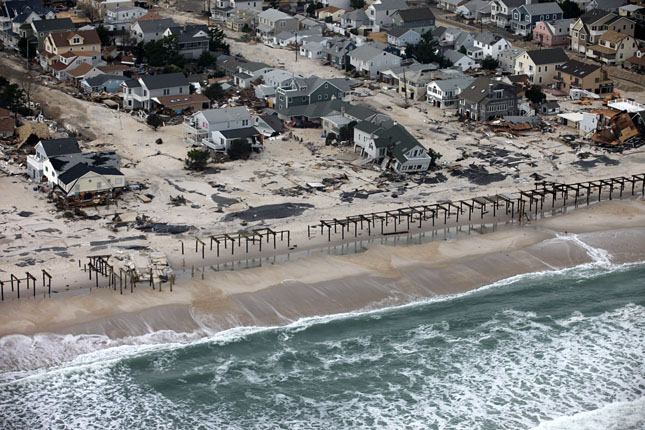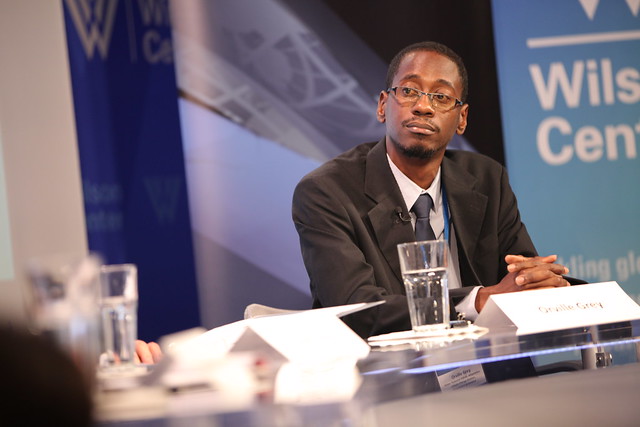-
What Happens When You Can’t Build Back? Addressing Climate Change Loss and Damage
April 7, 2016 By Haodan "Heather" Chen
The world is entering a new phase of climate change defined by “failure to mitigate sufficiently and failure to adapt sufficiently,” said Saleemul Huq, director of the Bangladesh-based International Center for Climate Change and Development, at the Wilson Center on March 16. [Video Below]
Shifting climate patterns and rising seas will affect many communities in ways they cannot fully avoid or adapt to, causing what the international climate community refers to as “loss and damage.” Hurricane Ivan in 2004, for example, caused damage to the Caribbean nation of Grenada equivalent to 200 percent of its annual GDP.
How to value loss and damage, how to compensate people for that value, and who pays for it are all open questions that can evoke strong emotions. There are places that are especially vulnerable to these effects, like small islands, whose very existence is threatened, but some of the richest countries also have the most valuable assets at risk.
“We must find innovative means of addressing loss and damage,” said David Estrin, senior research fellow at the Center for International Governance Innovation. “It is not only a matter of extreme weather; it’s also intensifying the effects climate change has had on other intractable problems, such as war, famine, and economic migration.”
“It’s a Matter of Climate Justice”
Loss and damage is “a matter of climate justice,” said Estrin. The most vulnerable people – those in developing countries with few assets to mobilize – have generally contributed the least to greenhouse gas emissions. Addressing loss and damage, then, is to some extent to address inequality.
“‘Losses’ refer to complete loss of something,” said Huq, for example “human life loss cannot be brought back by any amount of compensation… On the other hand ‘damages’ can be repaired – roads can be damaged and repaired.”
The impacts of loss and damage can be profound in both economic and noneconomic ways. The disappearance of islands, for example, can cost people enormous amounts of money as they have to relocate and reconstruct their lives, said Estrin. But there are more far-reaching results. “People do not just lose islands, but their homes, culture, language.” These losses can never be replaced and leave an ever-lasting trauma in human history.
The Paris Agreement Is Not Enough
The United Nations Framework Convention on Climate Change (UNFCCC) first began addressing loss and damage in 2013 at the Warsaw conference, COP-19. The Warsaw International Mechanism for Loss and Damage was established to provide a platform to expand our understanding of climate change consequences and to find an appropriate approach to addressing loss and damage.
The Paris Agreement, agreed to by nearly all countries at COP-21 last fall, continued support for the Warsaw Mechanism and recognized loss and damage as a separate issue from adaptation, mitigation, and other major sub-heads for the first time.
The 22nd Conference of Parties in Marrakech this fall will see the results of the Warsaw Mechanism’s three-year mandate with a report on its findings and information on the next steps for loss and damage within the UNFCCC.
Though an important milestone in many respects, the Paris Agreement does not get the world out of the woods, said Estrin. There’s nothing in the text that requires specific reductions by specific countries within specific periods, he said, leaving open the possibility that mitigation efforts will progress too slowly.
According to the International Energy Agency, 66 percent of current proven fossil fuel reserves must remain in place to avoid the two-degree Celsius warming limit agreed to by all nations. Another study conducted by Carbon Tracker claims that 80 percent of current reserves must remain untapped to achieve “safe” levels of warming.
The Paris text does not touch on these reserves, creating a potential bomb for global warming, said Estrin. A warming scenario beyond two degrees Celsius would create escalating levels of loss and damage, putting more and more pressure on whatever mechanism the global community decides on for valuation and compensation.
Who Pays?
As it is currently envisioned, loss and damage is primarily focused on financial compensation. Especially for developing countries, having sustainable and independent financing is the primary concern. Huq proposed two feasible funding solutions, one on the national level and the other on the international level.
At the national level, Huq suggested a government-managed reserve fund. Bangladesh, for example, has put more than $500 million toward climate adaptation, mitigation, and emission reduction since 2008. In over seven years, only two thirds of the funds have been spent, however; the rest are reserved for emergency purposes. The government is now trying to use some of that money to develop a national mechanism on loss and damage, which would define how it gets used, when it gets triggered, and who gets the money.
$2 per ton of carbon dioxide emitted from burning fossil fuels would add up to $50 billion a year“This is an extremely innovative idea that the government of Bangladesh is taking forward,” Huq said, as it would enable the country to take immediate compensatory action without waiting for international aid.
At the international level, Huq said a global carbon tax is in many ways the most logical approach. A $2 levy on every ton of carbon dioxide emitted from burning fossil fuels would add up to $50 billion a year, he said, roughly the amount supposed to cover adaptation costs for the entire developing world. Such a tax would raise money not from ordinary citizens, who are in large part not responsible for the problem, but from polluters, while at the same time serving as an incentive to reduce emissions as quickly as possible.
Orville Grey, a senior climate officer in the office of the prime minister of Jamaica, discussed the possibility of new insurance schemes to help raise funds.
In 1993 and 1994 after losses from several hurricanes, reinsurance prices in the Caribbean reached 200 to 300 percent above those of 1989 and prior years, and correspondingly led to a drastic increase in insurance prices for individuals. This imposed a heavy financial burden on property owners, said Grey.
The evaluation and risk reassessment process for insurance companies can be also time-consuming, as it took some insurance companies more than nine months to evaluate and reassess the case of Hurricane Ivan in 2004.
Grey proposed a parametric weather insurance scheme that pays outs when weather exceeds certain thresholds – too much rain or too little – rather than waiting for losses to be confirmed. This would compensate vulnerable low-income individuals in time to avoid further loss and damage and recover more quickly following disasters.
The Caribbean Catastrophe Risk Insurance Facility (CCRIF), established in 2007 by Caribbean leaders and the World Bank with $47 million in reserve, provides a similar service to national governments by pooling risk and providing access to liquidity to participating governments if hit by a hurricane or earthquake. The goal is to get governments back to functioning as quickly as possible when faced with relatively overwhelming losses (e.g., in Grenada). It is viewed by the UNFCCC as the best practice example to be replicated in other regions of the world, Grey said.
Forward to Marrakech
As the effects of climate change accelerate – 15 of the 16 warmest years on record have occurred since 2001 – loss and damage will become more and more important.
More innovative finance solutions, whether levies on polluters or risk insurance schemes, are needed. The question of who should pay will likely remain a major point of negotiation at the UNFCCC. Some, for example, balk at traditional insurance schemes because they require ordinary people to pay premiums to protect against a problem they did not cause.
If left unaddressed, however, the issue may further develop into a major human rights issue and impair human equality. According to a report published by World Bank, there is a high possibility that the poor will suffer most from climate change disruption and dislocation, especially if the two-degree Celsius target is exceeded.
COP-22 in Morocco this fall will begin to address some of these questions, as more specific solutions for both economic and non-economic loss and damage caused by rapid onset climatic events (e.g. floods and hurricanes) and slow onset events (e.g. droughts and sea-level rise) will hopefully be developed.
“Clearly the issues of loss and damage are making themselves felt, seen, and heard on an ongoing basis,” said Thomas Lovejoy, a professor at George Mason University and ECSP and Brazil Institute advisory board member. “There is a trajectory of global change that is driving loss and damage in even larger and even more complex ways, and at the same time the solutions have to be very sophisticated too.”
Event Resources:
Sources: Carbon Tracker, Germanwatch, International Energy Agency, NASA, Nature, Reliefweb, United Nations Framework Convention on Climate Change, World Bank.
Photo Credit: The aftermath of Hurricane Sandy along the New Jersey shore, November 2012, courtesy of Greg Thompson/U.S. Fish and Wildlife Service.
Topics: adaptation, Bangladesh, Caribbean, climate change, COP-19, COP-21, COP-22, development, disaster relief, economics, environment, environmental security, featured, flooding, From the Wilson Center, funding, international environmental governance, Latin America, livelihoods, loss and damage, risk and resilience, UN, video
 A Publication of the Stimson Center.
A Publication of the Stimson Center.




